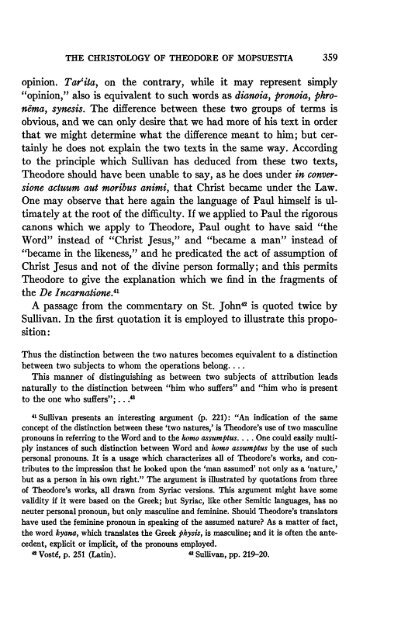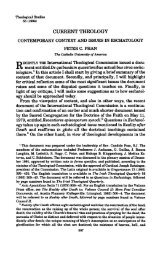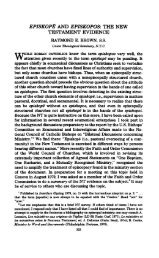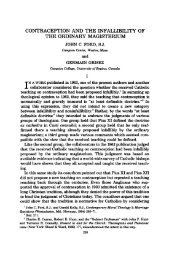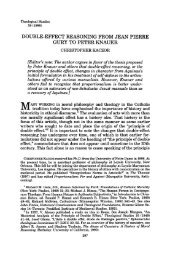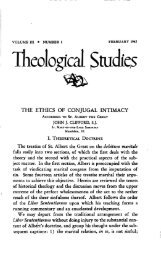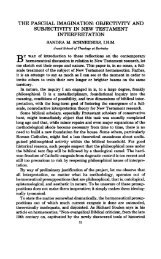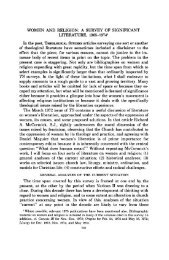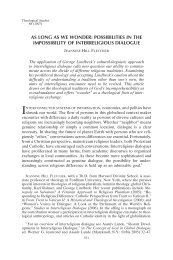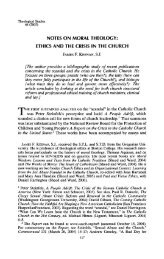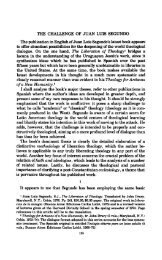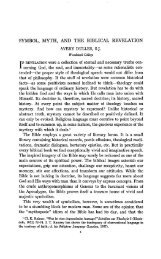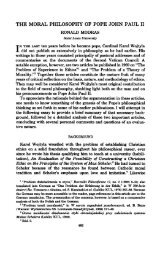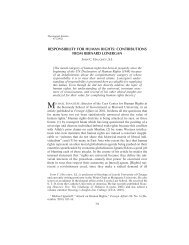ANNOTATIONS ON THE CHRISTOLOGY OF THEODORE OF ...
ANNOTATIONS ON THE CHRISTOLOGY OF THEODORE OF ...
ANNOTATIONS ON THE CHRISTOLOGY OF THEODORE OF ...
Create successful ePaper yourself
Turn your PDF publications into a flip-book with our unique Google optimized e-Paper software.
<strong>THE</strong> <strong>CHRISTOLOGY</strong> <strong>OF</strong> <strong>THE</strong>ODORE <strong>OF</strong> MOPSUESTIA 359<br />
opinion. Tar'ita, on the contrary, while it may represent simply<br />
"opinion," also is equivalent to such words as dianoia, pronoia, phronema,<br />
synesis. The difference between these two groups of terms is<br />
obvious, and we can only desire that we had more of his text in order<br />
that we might determine what the difference meant to him; but certainly<br />
he does not explain the two texts in the same way. According<br />
to the principle which Sullivan has deduced from these two texts,<br />
Theodore should have been unable to say, as he does under in conversions<br />
actuum ant moribus animi, that Christ became under the Law.<br />
One may observe that here again the language of Paul himself is ultimately<br />
at the root of the difficulty. If we applied to Paul the rigorous<br />
canons which we apply to Theodore, Paul ought to have said "the<br />
Word" instead of "Christ Jesus," and "became a man" instead of<br />
"became in the likeness," and he predicated the act of assumption of<br />
Christ Jesus and not of the divine person formally; and this permits<br />
Theodore to give the explanation which we find in the fragments of<br />
the Be Incarnatione* 1<br />
A passage from the commentary on St. John 42 is quoted twice by<br />
Sullivan. In the first quotation it is employed to illustrate this proposition:<br />
Thus the distinction between the two natures becomes equivalent to a distinction<br />
between two subjects to whom the operations belong. . ..<br />
This manner of distinguishing as between two subjects of attribution leads<br />
naturally to the distinction between "him who suffers" and "him who is present<br />
to the one who suffers";.. . tt<br />
41 Sullivan presents an interesting argument (p. 221): "An indication of the same<br />
concept of the distinction between these 'two natures,' is Theodore's use of two masculine<br />
pronouns in referring to the Word and to the homo assumptus. . . . One could easily multiply<br />
instances of such distinction between Word and homo assumptus by the use of such<br />
personal pronouns. It is a usage which characterizes all of Theodore's works, and contributes<br />
to the impression that he looked upon the 'man assumed' not only as a 'nature,'<br />
but as a person in his own right." The argument is illustrated by quotations from three<br />
of Theodore's works, all drawn from Syriac versions. This argument might have some<br />
validity if it were based on the Greek j but Syriac, like other Semitic languages, has no<br />
neuter personal pronoun, but only masculine and feminine. Should Theodore's translators<br />
have used the feminine pronoun in speaking of the assumed nature? As a matter of fact,<br />
the word kyana, which translates the Greek physis, is masculine; and it is often the antecedent,<br />
explicit or implicit, of the pronouns employed.<br />
42 Voste*, p. 251 (Latin). « Sullivan, pp. 219-20.


